2012 VOLKSWAGEN GOLF PLUS key
[x] Cancel search: keyPage 240 of 541
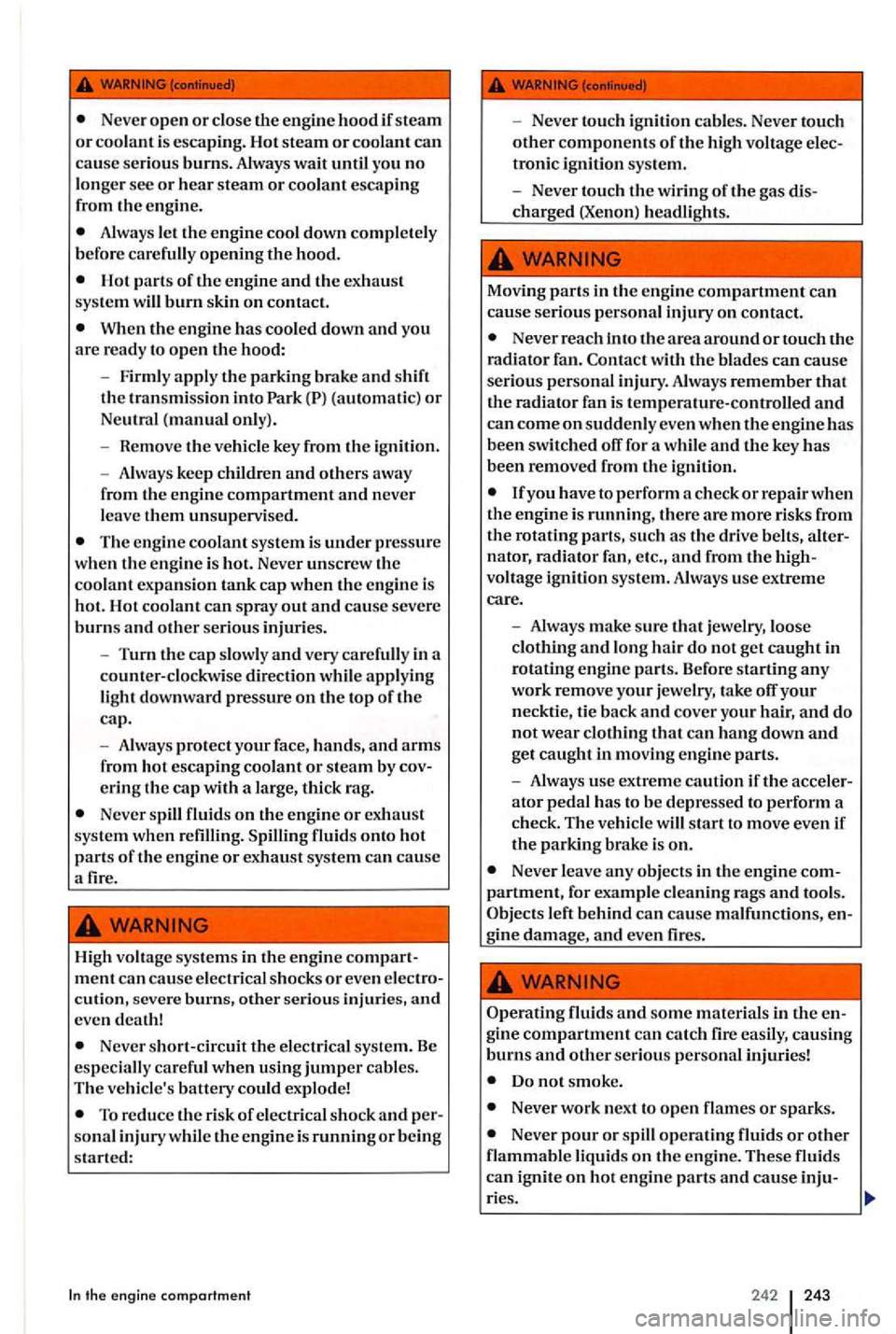
Never open or close the engine hood if steam or coolant is escaping. Hot steam or coolant can cause serious burns. Always wait until you no longer sec or hear steam or coolant escaping
from the engine.
Hot parts of the engine and the exhaust
system will burn skin on contact.
When the engine has cooled down and you are ready to open the hood:
- Firmly
apply the parking brake and shift the transmission into Park
The engine coolant system is under pressure when the engine is hot. Never unscrew the coolant expansion tank cap when the engine is
hot. Hot coolant can spray out and cause severe burns and other serious injuries.
- Turn
the cap slow ly and very carefully in a
counter-clockwise direction while applying
light downward pressure on the top of the cap.
- A
lways protect your face, hands, and arms from hot escaping coolant or steam by
Never spill fluids on the engine or exhaust
system when Spilling fluids onto hot parts of the engine or exhaust system can cause a fire.
High voltage systems in the
engine com ment can cause electrical shocks or even
Never short-circuit the electrical system. Be especially careful when using jumper cables. The vehicle's battery could explode!
To reduce the risk of electrical shock and sonal injury while the engine is running or being started:
the engine compartment
- Never touch ignition cables. Never touch other components of the high voltage tronic ignition system.
- Never touch
the wiring of the gas
Never reach into t11e area around or touch the
radia tor fan. Contact with the blades can cause serious personal injury. Always remember that the radiator fan is temperature-controlled and can come on suddenly even when the engine has been switched for a while and the key has been removed from the ignition.
lfyou have to perform a check or repair when the engi ne is running, there are more risks from tl1e rotating parts, such as the drive belts, nator, radiator fan, etc ., and from voltage ignition system. Always use extreme care.
- Always make
sure that jewelry, loose clothing and long hair do not get caught in rotating engine parts. Before starting any work remove your je welry, take
parking brake is on.
Never leave any objects in the engine
left behind can cause malfunctions,
Do not smoke.
Never work next to open flames or sparks.
Never pour or spill operating fluids or other flammable liquids on the engine. These fluids can ignite on hot en g in e parts and cause ries .
242 243
Page 242 of 541
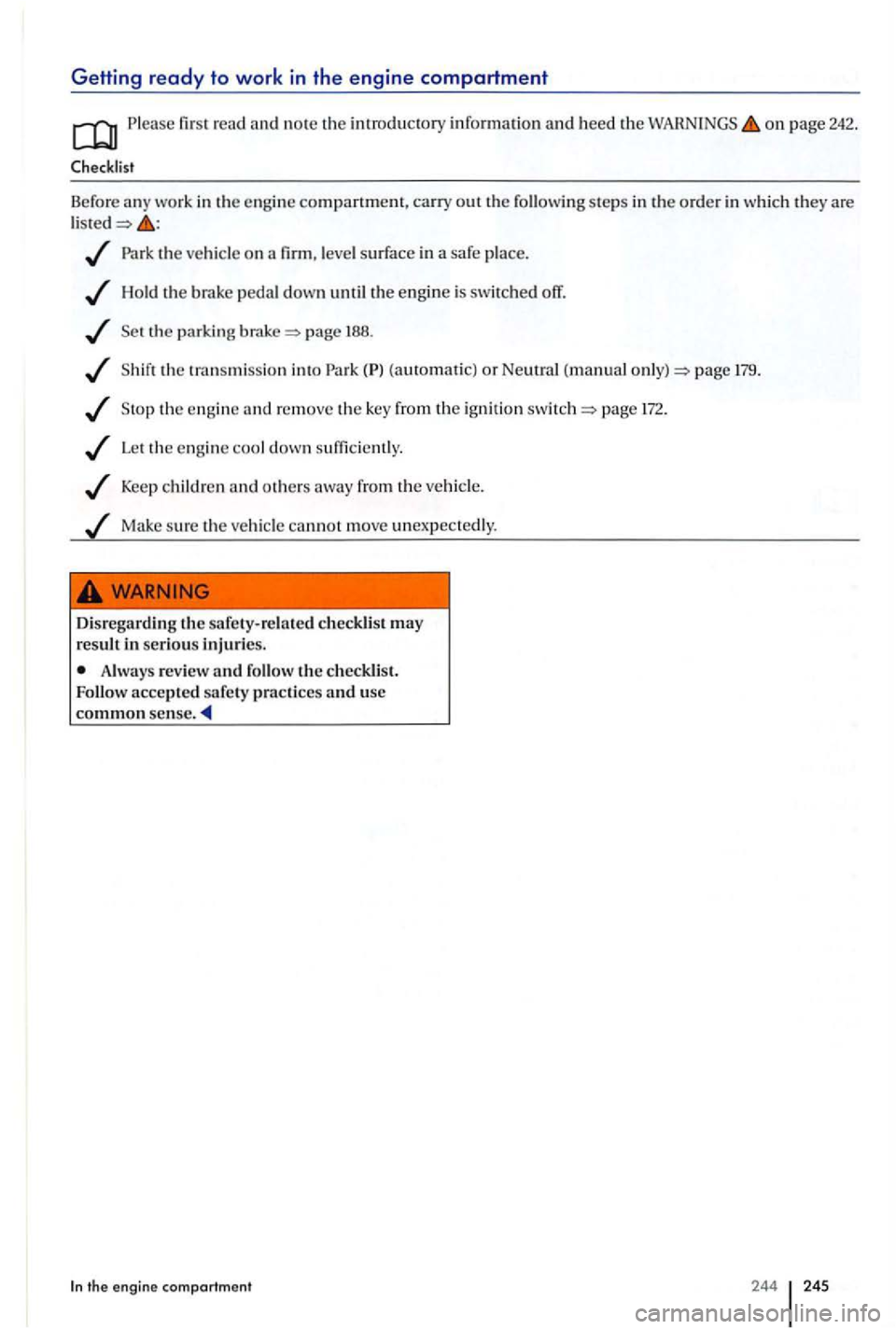
GeHing ready to work in the e ngine compartment
Please on page 242.
Checklist
Before any work in the engi ne companment, carry out the follo wing steps in the order in whi ch they are
Par k the ve hicl e on leve l surface in a safe place.
Hold the pedal down until the engin e is switched off.
page
S hift the tran smissio n into (automatic) or (manual page 179.
S top the engi ne and remove the key fro m the ignition pag e
Le t th e eng in e cool d ow n
Keep child re n and o th ers from the ve hicl e.
Make sure th e ve hicle cannot move unexpe ctedly.
Dis regardi ng the safe ty- re lated checkli st may
result in serious injuries.
Alwa ys review use common
Page 252 of 541
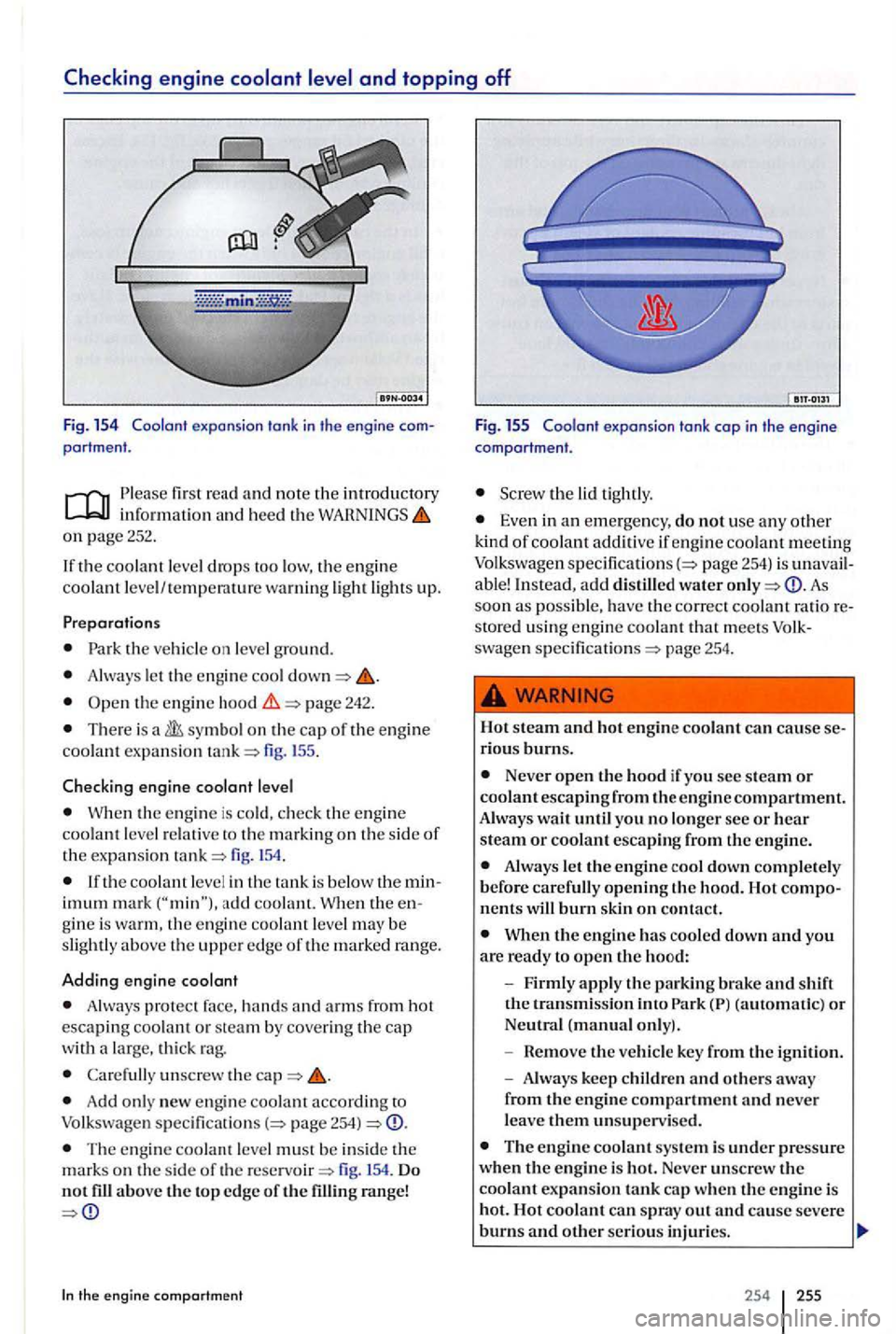
read and note the introductory
on page 252.
If th e coolant level drops too low, the engin e
coo lant level/ tempe ratur e warni ng ligh t lights up.
Park the ve hicl e on level ground.
Always let the engin e cool
th e engine hood
There is a fig.
When the eng in e is co ld, check the e ngine
coolant leve l relat ive to th e marking on th e sid e of th e expa nsio n tank fig. 154.
Always protec t face, hands and arms from h ot
escaping coo lant o r steam by cover ing the cap with a larg e, thi ck rag.
Carefully unsc rew the
Add new engine co olant ac co rding to Volkswagen specifications page 254)
Th e engi ne coo lant leve l must b e in sid e the mark s on the sid e of the 154. Do
not above top edge of the
the engine compartment
Fig. 155 Coolan t e xpans ion tank cap in the eng in e
compartment.
Screw the lid tightly.
Even in a n em erge ncy, do not use any other kind of coolant addi tive if eng ine coolant meeting
Volkswagen pa ge 254) is una v ail
able! Instead, add distilled water
page 254.
H
ot steam and hot engin e coo lant can cause se
rio us burns.
Never open the hood if yo u sec steam o r coolant esca ping from the engine compartment. Always wait until you no longer see or hear steam or coolant escapin g from the engine.
Always let the e ngin e cool down compl etel y
before carefully opening th e hood.
When the engin e has coo le d down and you are ready to open hood:
- F
irmly apply the parking brake and shift (automatic) o r Neutral (manual only).
- Hemov e
the vehicl e key from the ignition.
- Always keep c
hildren and others away from the en gin e compartment and never
leave them unsupervise d.
The engine coolant system is under pressure
w hen the engine is hot. Neve r unscrew the coolant expansion tank cap whe n the engine is hot. Hot coolant can spray out and ca use severe burns and other serious injuri es.
254 255
Page 311 of 541
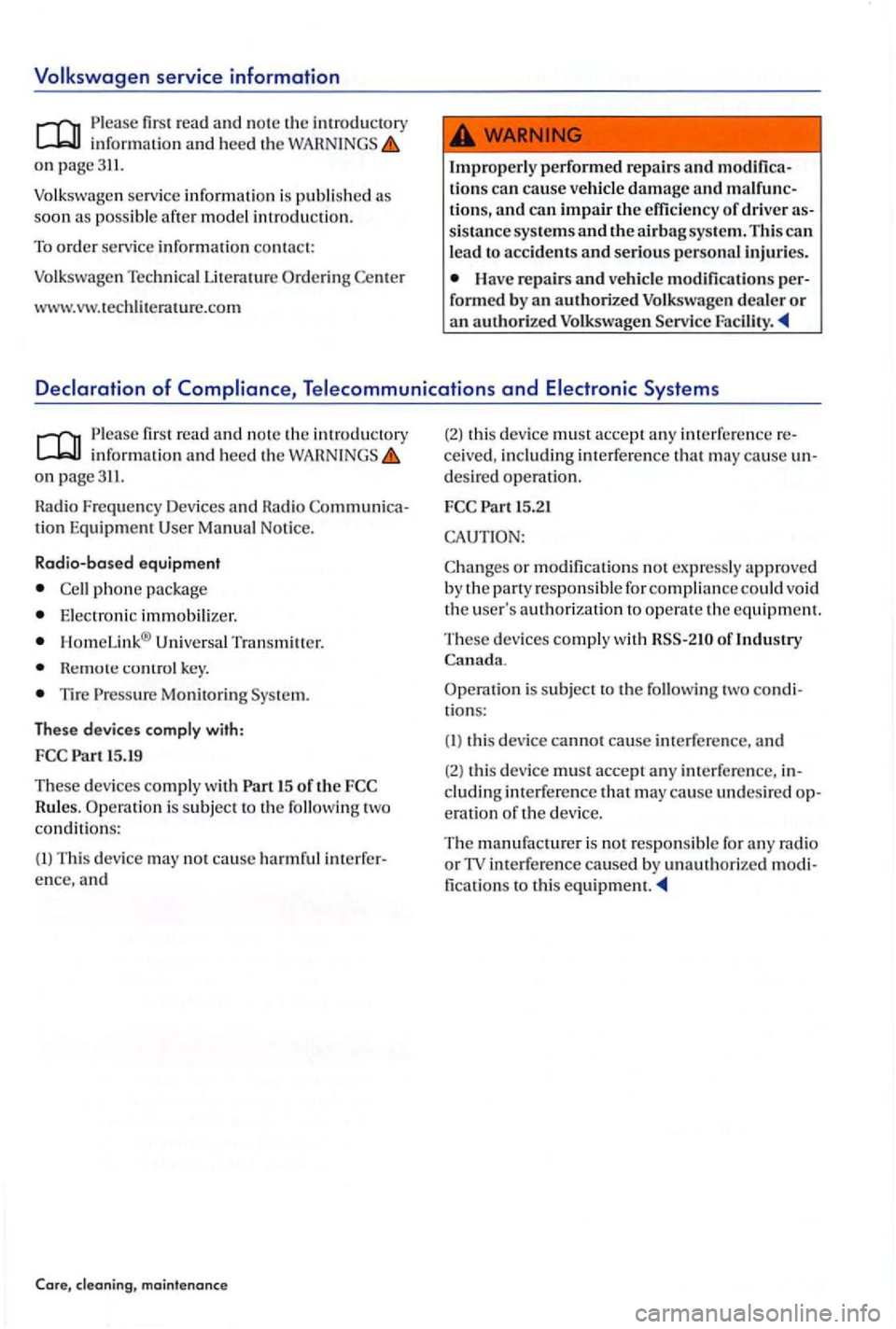
Volkswagen service information
Please fir st r ead and information and heed the on page
Volkswag en service information is publi sh ed as
soon a s poss ible afte r model introdu ction.
To order serv ice info rmati on contact
Volkswagen Technical Litera ture Orderi ng
www.vw.tec hliterature.com
Improperly performed repairs and modifica
tions can cause vehic le damage and tion s, and can impair the efficie ncy of driver sistance systems and the airbag system. This can lead to accidents and serious personal injuries.
H ave repairs and vehicle modification s formed by an authorized Volkswagen dealer or an authori zed
Telecomm unications and Elect ronic Systems
first r ea d and note the introductory information and heed th e on
Communica
tion Equipment Manual Notice.
Radio-based equipment
Cell phone package
Electronic immobili zer.
HomeLin k® Uni versa l Transm iller.
key.
Tir e Monitoring
These devices comply with:
FCC Pa
rtl5.19
T h
ese devices compl y with is s ubj ect to the followin g
Thi s dev ice may not cause ha rmful ence , and
Core,
ceived , includin g interferenc e may cause desired operatio n.
FCC
15.21
C ha nges or modifica tion s no t express ly approved
by the parry responsible for complia nce could void
th e user's authoriza tion to operate the equipment.
Th
ese d ev ices compl y with of Industry Canada.
is s ubj ect to the following two tions:
( I) thi s device cannot ca use interfe rence. and
(2) thi s device must accept any imerfe re n ce, cl ud in g interference that m ay cause undes ired
fication s to this equipm ent .
Page 315 of 541
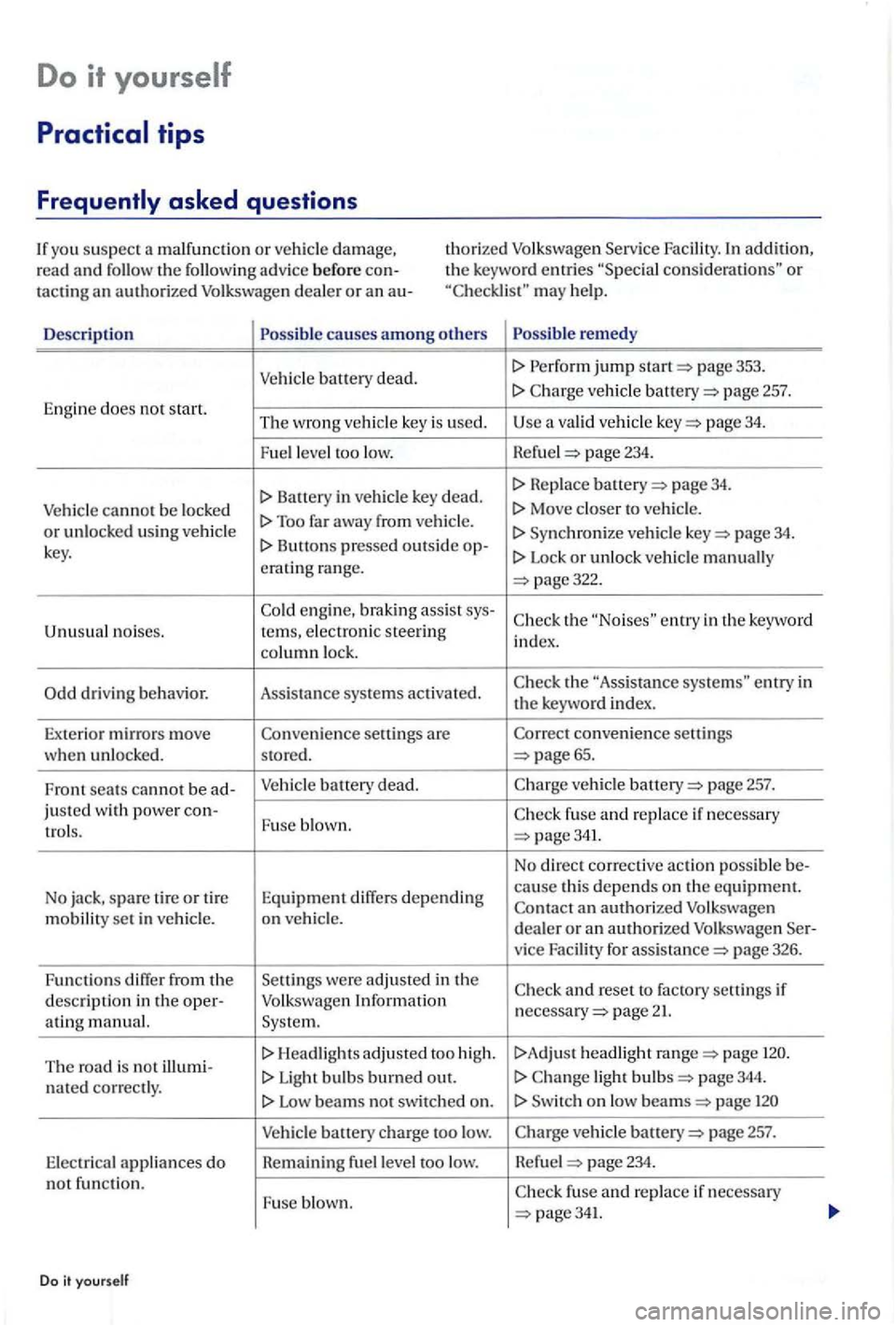
Do it yourself
con sid era tions" or may help.
De
scription causes amon g oth ers remed y
Vehicl e ba tt ery dead. jump page 353.
page 257. Engine does no t start. The wrong ve hicle key is used. a valid ve hicl e page 34.
Fuel leve l too low. Hefue l 234.
Batt ery in ve hicl e key dead. page 34.
Vehicle cannot be locke d Too far away from vehicle . Sy nchroni ze veh icle page 34. key. Lock or unlo ck vehicl e manually
crat ing range. page322.
en gine, braking assis t sys-th e entry in the ke yword noises. te rns, e lectro nic steering index.
co lumn lock.
the "Assis tance e ntry in the keywo rd in dex .
Exterior mirro rs move convenience settings
w he n unl ocke d . stored. 65.
F ront seats can not be ad -Vehicle battery dead. veh icle page 257.
jus ted with power con-Fuse b lown.
a n authoriz e d Volkswage n
m obilit y se t in vehicle. on ve h icl e. dealer or an authori zed Volk swagen Ser-
v ice Facility for page 326.
Func tions diff
er from th e Settin gs were adju ste d in th e and reset to fac tory settings if
descript ion in the oper-Volkswagen Information page 2 ating manual. Syste m.
T he road
is not illumi-H ea dlights a djusted too hig h . !>A dju st headlig ht page
n a ted correctly. Light b ulb s burned out. ligh t page 344.
Low beams no t swi tched on . Switch on low page
Vehicle battery ch a rge too low. page 257.
E lect rica l a p plian ces do Remaining fuel le vel too low. Refu el page 234. not functi on.
page341.
Do it yourself
Page 317 of 541
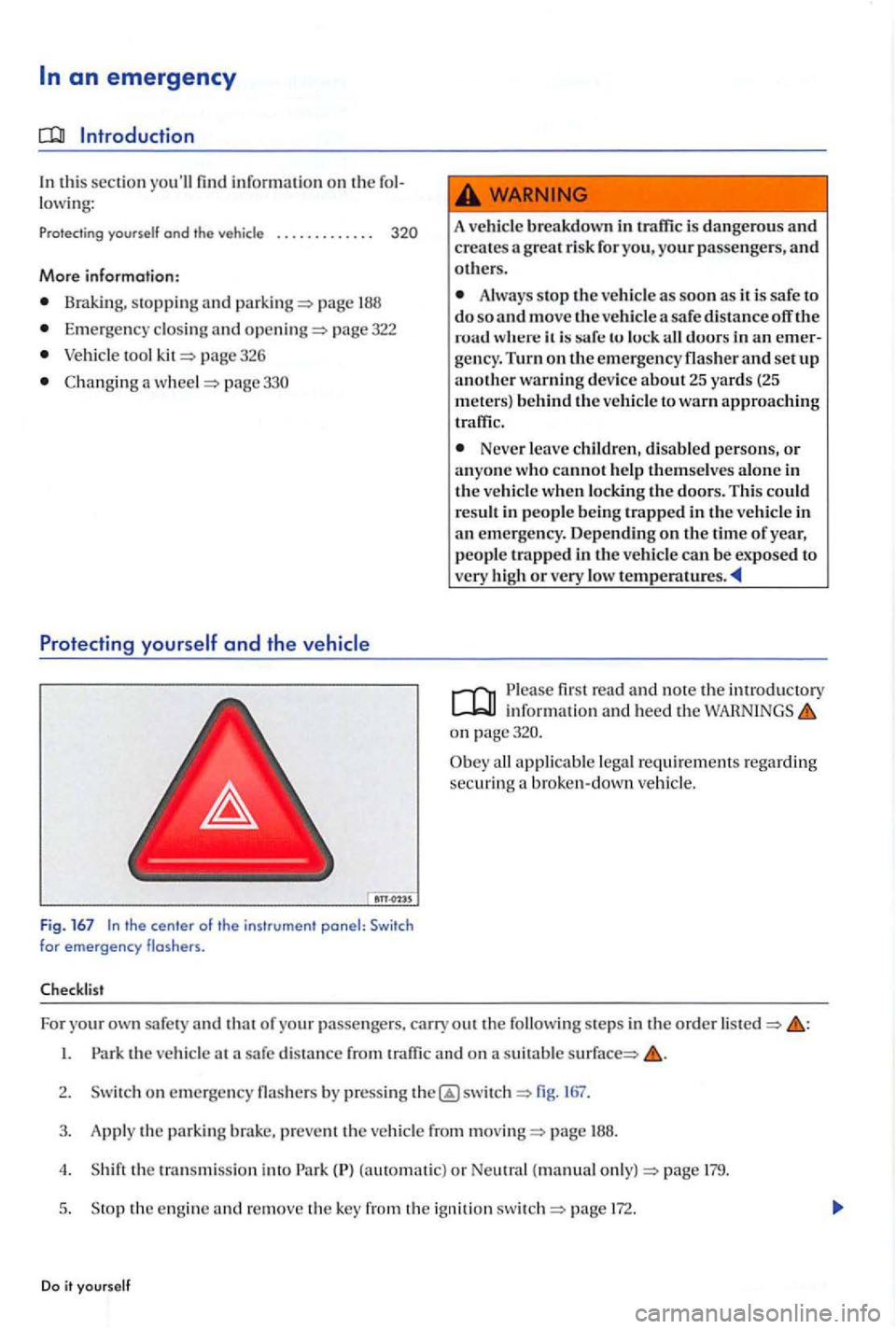
Introduction
In this section yo u'll informati on on th e lowi ng:
Prote cting yourself and the vehicle . . . . . . . . . . .
More information:
B ra king, sto ppin g and page
Em erg ency clos ing and page 322
Ve hicl e tool page326
Chan ging a page
Protecting you rse lf and the vehicle
Fig. 167 the center of the instrument panel: for emergency
A vehicle breakdown in
Always stop the vehicle as soon as it is safe to do so and move th e ve hicle a safe distance off the tu all duurs in
Neve r leave children, disable d persons, or anyone who cannot help themselves alone in th e ve hicl e when locking the doors. This could
result in people being trap ped in the vehicle in
a n em erge ncy. Depending on the tim e or year, people trapped in tl1e vehicl e can be exposed to
very high or very low tempe ratures.
fir st rea d and no te th e introdu ctory info rmati on and heed the
on
all appli cabl e leg al require m ent s re garding securin g a broke n- down ve hicl e.
For yo
ur safe ty and th at of your pa sse ngers, carry out th e followin g ste ps in the o rder
on em erge ncy flashers by p ress ing 167.
3. Appl y th e parkin g brake, preve nt the ve hicl e from page 188.
4 . th e tran smi ssio n int o (automati c) or Neutra l (manua l page 179.
5 . Stop th e e ngin e and re move th e key from th e ig niti on page 172.
Do it yourself
Page 318 of 541

Checklist (continued )
6. passengers exit and go to a safe locatio n
vehicl e keys with you when lea vin g yo ur ve hicl e.
8. up ale rt other m otoris ts and cycl is ts .
9. Let th e eng in e cool down and ge t ex pert ass is tance if necessary .
the emerge ncy flashers are on. use the turn sig nal lever to indicat e when the ve hicl e is bein g towe d. T his
t empo rarily interr upts th e wa rnin g fla sh ers.
Traffi c suddenl y slows down or s top s in front of you to wa rn those approaching fro m b ehind .
the of an em erge ncy.
the ve hicle brea ks dow n.
b ein g tow-s tarted or bei ng towed.
A lways obey traffic
that govern the use o f
e m erge ncy flash ers where you are driving.
th e em ergency flash e rs are not working . a fe rent method -as pe rmitt ed by law-must b e
used to alert othe r m otoris ts an d cycl is ts to the breakdown.
Di sregarding the sa fety-related ch ecklist may lead to accidents and serio us injuries.
A lway s review and th e c hecklist. safe ty prac tice s and use common sense.
Pract ical tips
Th e vehicl e ex hau st syst em and the ca tal ytic
co nverter or diesel pa rti cu late
Never park where parts of the hot ex haust sys te m or catalyti c converter could ignite mable materials, such as dry grass, brush ,
l eaves,
T he ve hicl e battery be drained if th e em ergency flas he rs are o n for a long tim e
To alert the traffi c behind you, th e brake light s o n some ve hicle s sta rt to fla sh if you
brake hard when traveling at a speed greate r about mph km /h ).
a t speeds around 6 mph
ating d eact iva tes th e e merge ncy flash ers.
To alert the tr affic behin d you, the ge ncy flashers on so me ve hicl es come on if you br ake hard w hen traveling at a speed greater than mph krn/h ). accele ratin g
o r continuing to drive at a speed above about25 mph km /h ), th e e merge ncy flashers
Page 319 of 541
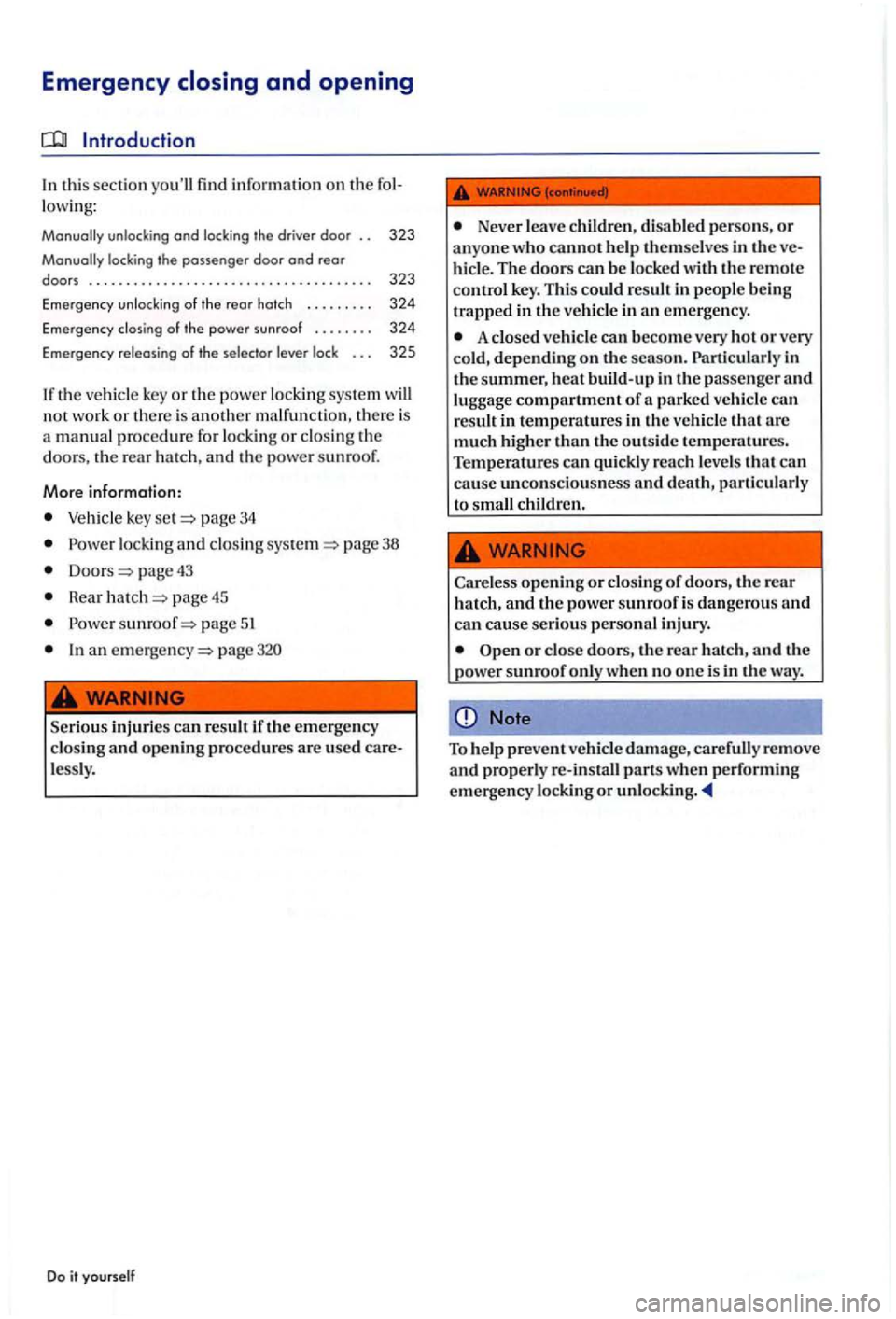
Emergency
In thi s sec tion i nfor mation on the lowing:
Manually unlocking and locking the driver door . . 323
the rear a nd th e power su nro of.
Mor e informa tion :
Vehicle key set page 34
lock ing and closin g pa ge 38
page 43
Rear page 45
In an pag e
Neve r leave children, disabl ed p ersons, or anyo n e hicl e. The doors can b e loc ke d
A closed ve hicle can b eco me very ho t o r ve ry
co ld, de pendin g on the seaso n. Partic ularl y in
th e summer, heat build-up in the passe nge r and
lu gg ag e compartment of a park ed vehicl e can
result in tempe ratu res in the v ehicl e th at are much high er th an the outsid e temperatures.
T emperatures can q uickl y reach leve ls th at can
ca use unco nscio usn ess and d eath, particul arl y
t o s mall children.
Care less op en in g o r cl
osin g o f doo rs, the rear hatch, and th e power sunroof is dan gerou s and ca n cause seri ou s personal inju ry.
or cl ose doors , th e rear h atc h , and the
p owe r sunroo f o nl y w hen n o one is in th e w ay.
Note
T o h elp preve
nt ve hicl e dam age, care full y re move
and p ro perl y re -in stall parts w hen performi n g
e m ergency locking or